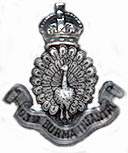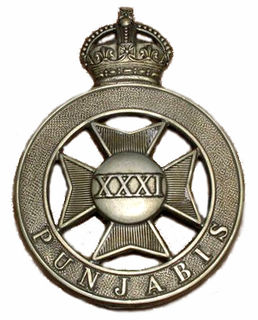The Punjab Regiment is an infantry regiment of the Pakistan Army. The modern regiment was formed in 1956 from an amalgamation of the 1st Punjab Regiment, 14th Punjab Regiment, 15th Punjab Regiment and 16th Punjab Regiment. Since then the regiment has expanded in strength to now include 74 battalions.

The 16th Punjab Regiment was a regiment of the British Indian Army from 1922 to 1947. It was transferred to Pakistan Army on Partition of India in 1947, and amalgamated with the 1st, 14th and 15th Punjab Regiments in 1956 to form the Punjab Regiment.

The 1st Punjab Regiment was a regiment of the British Indian Army from 1922 to 1947. It was transferred to the Pakistan Army on independence in 1947, and amalgamated with the 14th, 15th and 16th Punjab Regiments in 1956, to form the Punjab Regiment.

The 15th Punjab Regiment was a regiment of the British Indian Army from 1922 to 1947. It was transferred to Pakistan Army on independence in 1947, and amalgamated with the 1st, 14th and 16th Punjab Regiments in 1956 to form the Punjab Regiment.

The 8th Punjab Regiment was a regiment of the British Indian Army from 1922 to 1947. It was transferred to Pakistan Army on Partition of India in 1947 and merged with the Baluch Regiment in 1956.

The 62nd Punjabis was an infantry regiment of the British Indian Army. It was raised in 1759 as the 3rd Battalion of Coast Sepoys, and formed part of the Madras Army. It was designated as the 62nd Punjabis in 1903 and became 1st Battalion 1st Punjab Regiment in 1922. In 1947, it was allocated to the Pakistan Army, where it continues to exist as 1st battalion, Punjab Regiment. It is the senior-most surviving infantry battalion of the British Indian Army.

The 66th Punjabis was an infantry regiment of the British Indian Army. It was raised in 1761 as the 7th Battalion of Coast Sepoys. It was designated as the 66th Punjabis in 1903 and became 2nd Battalion 1st Punjab Regiment in 1922. In 1947, it was allocated to the Pakistan Army, where it continues to exist as 2nd Battalion The Punjab Regiment.

The 76th Punjabis was an infantry regiment of the British Indian Army. It was raised by Captain Thomas Lane at Trichonopoly on 16 December 1776, as the 16th Carnatic Battalion. It was designated as the 76th Punjabis in 1903 and became the 3rd Battalion 1st Punjab Regiment in 1922. In 1947, it was allocated to the Pakistan Army, where it continues to exist as 3rd Battalion The Punjab Regiment.

The 82nd Punjabis was an infantry regiment of the British Indian Army. It was raised in 1788, as the 29th Madras Battalion. It was designated as the 82nd Punjabis in 1903 and became the 5th Battalion 1st Punjab Regiment in 1922. In 1947, it was allocated to the Pakistan Army, where it continues to exist as 4th Battalion The Punjab Regiment.

The 29th Punjabis was an infantry regiment of the British Indian Army. It was raised in 1857, as the 21st Regiment of Punjab Infantry. It was designated as the 29th Punjabis in 1903 and became 10th (Training) Battalion of 15th Punjab Regiment in 1922. In 1943, it was converted into the 15th Punjab Regimental Centre. In 1947, the 15th Punjab Regiment was allocated to the Pakistan Army. In 1956, the 1st, 14th, 15th and 16th Punjab Regimental Centres where amalgamated to form the Punjab Regimental Centre.

The 89th Punjabis was an infantry regiment of the British Indian Army raised in 1798 as a battalion of Madras Native Infantry. It was designated as the 89th Punjabis in 1903 and became 1st Battalion 8th Punjab Regiment in 1922. In 1947, it was allocated to Pakistan Army, where it continues to exist as 1st Battalion, The Baloch Regiment.

The 93rd Burma Infantry was an infantry regiment of the British Indian Army. The regiment was raised in 1800 as a battalion of Madras Native Infantry. It was designated as the 93rd Burma Infantry in 1903 and became the 5th (Burma) Battalion 8th Punjab Regiment in 1922. In 1947, it was allocated to the Pakistan Army, where it continues to exist as 5th Battalion of The Baloch Regiment.

The 9th Bhopal Infantry was an infantry regiment of the British Indian Army.It was raised by Nawab of Bhopal in 1818 near Sehore. It was re-raised in 1859, as the Bhopal Levy. The regiment was disbanned for participating in war against British during 1857. It was designated as the 9th Bhopal Infantry in 1903 and became 4th Battalion (Bhopal) 16th Punjab Regiment in 1922. In 1947, it was allocated to the Pakistan Army, where it continues to exist as 17th Battalion The Punjab Regiment / 17 Punjab Haidri.
The 21st Punjabis were an infantry regiment of the British Indian Army. It was raised in 1857, as the 11th Regiment of Punjab Infantry. It was designated as the 21st Punjabis in 1903 and became 10th (Training) Battalion of 14th Punjab Regiment in 1922. In 1943, it was converted into the 14th Punjab Regimental Centre. In 1947, the 14th Punjab Regiment was allocated to the Pakistan Army. In 1956, the 1st, 14th, 15th and 16th Punjab Regimental Centres where amalgamated to form the Punjab Regimental Centre.

The 25th Punjabis was an infantry regiment of the British Indian Army. It was raised in 1857, as the 17th Regiment of Punjab Infantry. It was designated as the 25th Punjabis in 1903 and became 1st Battalion 15th Punjab Regiment in 1922. In 1947, it was allocated to the Pakistan Army, where it continues to exist as 9th Battalion The Punjab Regiment.

The 26th Punjabis were an infantry regiment of the British Indian Army. It was raised in 1857, as the 18th Regiment of Punjab Infantry. It was designated as the 26th Punjabis in 1903 and became 2nd Battalion 15th Punjab Regiment in 1922. In 1947, it was allocated to the Pakistan Army, where it continues to exist as 10th Battalion The Punjab Regiment.

The 30th Punjabis were an infantry regiment of the British Indian Army. It was raised in 1857, as the 22nd Regiment of Punjab Infantry. It was designated as the 30th Punjabis in 1903 and became 1st Battalion 16th Punjab Regiment in 1922. In 1947, it was allocated to the Pakistan Army, where it continues to exist as 13th Battalion The Punjab Regiment.

The 31st Punjabis was an infantry regiment of the British Indian Army. It was raised in 1857, as Van Cortlandt's Levy. The regiment was designated as the 31st Punjabis in 1903 and became 2nd Battalion 16th Punjab Regiment in 1922. In 1947, it was allocated to the Pakistan Army, where it continues to exist as 14th Battalion The Punjab Regiment.

The 33rd Punjabis was an infantry regiment of the British Indian Army. It was raised in 1857, as the Allahabad Levy. It was designated as the 33rd Punjabis in 1903 and became 3rd Battalion 16th Punjab Regiment in 1922. In 1947, it was allocated to the Pakistan Army, where it continues to exist as 15th Battalion The Punjab Regiment.

The 46th Punjabis were an infantry regiment of the British Indian Army. It was raised in 1900, as the 46th (Punjab) Regiment of Bengal Infantry. It was designated as the 46th Punjabis in 1903 and became 10th (Training) Battalion of 16th Punjab Regiment in 1922. In 1943, it was converted into the 16th Punjab Regimental Centre. In 1947, the 16th Punjab Regiment was allocated to the Pakistan Army. In 1956, the 1st, 14th, 15th and 16th Punjab Regimental Centres where amalgamated to form the Punjab Regimental Centre.




















